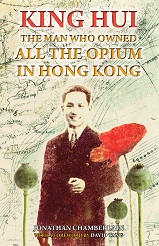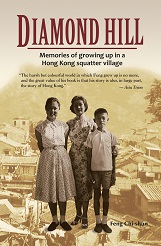|
by Pete Spurrier
  
  
People often express amazement that English-language publishers can survive in Hong Kong. I share their surprise. Hong Kong is a small place, and the mother tongue of 98% of its population is Chinese. Nevertheless, Hong Kong can be a reliable market for English books if you publish what people want. Over the past seven years, I've found that the most lasting appeal lies with the true-life stories of colourful Hong Kong people. There's no shortage of these; many of the older generation here have lived through "interesting times." These are the kind of books that I like too, so it's easy for me to maintain my interest in publishing and promoting them. More on these books later. I didn't really plan to be involved in book publishing. I was editing a local magazine, but SARS came along in 2003 and killed off most of our advertisers, and thereby the magazine itself. I was left at a loose end, and as I had some experience of working with designers and printers, I decided to take a chance and publish three books that some friends had been working on. These books were Hong Kong Cheap Eats by Nicole Lade—a dining guide for cost-conscious foodies; Adventures with Kids by Sarah Woods—a guidebook to Hong Kong for families and Sketches of Soho, an illustration of life around the Mid-Levels Escalator by artist Lorette Roberts. All three took off and sold quickly, so I carried on with book publishing and never looked back. Since then, I've discovered that roughly seven out of ten books I publish do well, and three don't. If those first books had been among the unlucky three, I would have stopped publishing there and then. Being in the book trade has given me the chance to meet and work with lots of amazing and talented people—for instance, Alain Robert, the French Spiderman, who wrote his autobiography. Authors are usually interesting people with a lot to talk about, and so are other publishers. There's creativity involved at all stages of book production. But it's not an easy business to succeed in. Publishing in general is going through a lot of changes at the moment, and book retailers are suffering as much as publishing houses. I am sometimes envious of publishers in the US and UK for having such large markets which can be served by a single distributor. Here in Asia, the book business is very fragmented. Hong Kong works well enough, but I need to sell through different distributors in Singapore, Malaysia, the Philippines and Thailand. Bookshops in China often have to be supplied individually, and the government-run chains there won't pay for books they have ordered. Japan is very hard to access. All these places have different import rules. Cash flow is always an issue: we usually work on consignment, so income rolls in piecemeal some months after a book goes on sale, but I can't ask designers and editors to wait that long to be paid. So how to succeed with books? Beyond the prerequisites of good writing, an existing readership for the subject matter and attractive design, it's all about promotion. Without it, a book just won't be noticed, no matter how good it is. Over 700,000 titles were published in the US alone in 2010. (A lot of those will have been self-published, as developments like print-on-demand technology have made this much easier these days). It's a staggering output. Among this ocean of titles, a lucky minority get a few weeks to prove their worth on bookshop shelves. A tiny proportion get reviewed by the media. Many sell only a dozen copies. Most sink without a trace. To avoid this happening, you need to get the word out about your book, using as many avenues as possible, and over an extended period of time. If you are lucky enough to get your books ordered by large chains, then you need to keep them moving by getting them talked about. This means approaching people in newspapers, magazines, radio, television, as well as bloggers, review websites, online reading communities, podcasts, social media and so on. Journalists often don't have the time to review books, but sometimes an excerpt from a book will be welcomed. Besides doing my best with the traditional media, I keep a Facebook page frequently updated, write a blog, tweet and send out an email newsletter. There is promotion to be done every day. We hold book launch parties and also attend fairs throughout the year, to meet readers face to face; these events do help move books, but also they act as good PR. When an author also gets stuck into the promotion of their book, this always brings results. A recognised author does have a "brand name" which people are receptive to. I hope many people in Hong Kong will have heard of Blacksmith Books, but no one is likely to buy everything we publish; however, if they like a particular author, they will eagerly follow news of another book they've written. Conversely, the writers who lament the poor sales of their books are generally the ones who have been almost invisible. I'd like to publish more novels—we get a lot of very good submissions of this nature—but the market for locally written fiction is very small. Still, I put out a couple of fiction titles every year which have some connection to local themes. One of my favourites is Apologies Forthcoming, a collection of short stories based on author Xujun Eberlein's experiences of the Cultural Revolution in China. Xujun is one of the writers who puts a lot of time into blogging and engaging with readers. Our bread and butter, though, is locally themed non-fiction. One of our bestsellers is King Hui: The Man Who Owned All the Opium in Hong Kong, a true story by Jonathan Chamberlain. In Hong Kong alone, we've sold nearly 5,000 copies of this biography: a rollercoaster tale of a local playboy who gambled, fought, robbed, womanised and collaborated his way through the most interesting years of the 20th century. I wish I had met Peter Hui, the subject of the book, but I'm proud to have been involved in publishing it. You don't need to believe every one of Hui's tales to benefit from his colourful descriptions of Hong Kong life in the decades before and after the Second World War. In the same line, Diamond Hill by Feng Chi-shun is a memoir of 1950s Hong Kong which has done very well, especially as it revives memories of a time when life was tough, but people could lift themselves out of poverty by their own hard work. Other successes have come in unexpected places. I took on Lama of the Gobi by Michael Kohn, despite its niche appeal, purely because it was an unusual book which expanded our Asian-angled catalogue to cover Mongolian stories. As expected, it didn't sell particularly well here. But in its first month on sale in the US, it moved 900 copies. I called the distributor over there, asking whether this was an error—but he said, "No, we always do well on the West Coast with Buddhism books." CHINA: Portrait of a People, a 640-page book of colour photographs by Tom Carter, was an ambitious project that almost brought us to grief. To bring the unit cost down and make it work, we had to print a reasonably high number of copies, but it didn't sell quickly enough to pay off the large printing bill and hoped-for sales in China didn't get very far. Again, enthusiastic sales in the US (and in Britain) saved us. I think it helps that China is always in the news these days. There are growing numbers of people in the West who want to learn more about how China works, and some of our books meet this need. After starting Blacksmith and putting out those first three books, I thought I would sit down and set out a plan for commissioning future titles. This never happened, because from day one I was deluged with manuscript submissions from all over the world. Though a majority of them are way off base (and that is ample material for another article), many of them are of high quality. It's great that so many good books are being written in fields that I like, and despite the financial and logistical struggles, I'm happy that I can make a living from bringing them to publication.
Things have definitely got easier since our catalogue passed the fifty-book mark. Suddenly, overseas book chains who wouldn't respond to us before started putting in orders.
We're now getting another ten to twelve books ready for publication in 2012; that's an annual output we try to stick to, as it's the highest number we have time to promote properly. My major objectives for the year ahead are to get more of our titles available in electronic formats; sell more foreign-language editions and to chip away at those places, notably Australia, we don't yet supply. |